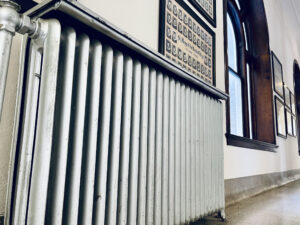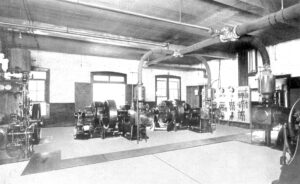By Karen Dyer, Vice President for Advancement and Strategic Initiatives

The radiator. You remember the one from your college dorm room that banged and sang as it came to life as temperatures fell each fall and boilers were lit.
The very one that made your room feel like a sauna as temperatures dropped below freezing.
The one that could keep your room toasty even as your windows stood wide open.
This radiator, just like the one in my Guerin Hall office at Saint Mary-of-the-Woods College, is both loved and maligned for its functional and fierce steam heat, but who would have guessed it was a marvel of technology and a prolific pandemic fighting machine?
The virtues of steam heat and the use of the radiator as a pandemic weapon, according Dan Holohan, author of the book, The Lost Art of Steam Heating, came about following the turn of the 20th Century’s “fresh air movement” and the rise in the belief that stale, indoor air contributed to the proliferation of disease. According to Holohan, groups such as the Anti-Tuberculosis League made pleas in the early 1900s to keep bedroom windows open to help prevent influenza, pneumonia and tuberculosis.
He notes in his research, the 1918 Spanish Flu Pandemic further popularized the idea of healthy, outdoor air and open windows as a deterrent to contagion. As a result, engineers began to intentionally design radiators larger than necessary for spaces so that they could warm a room on the coldest day of the year with the windows open, says Holohan.
“Every student who has lived in Le Fer remembers it snowing in their room. It would be so hot you had to open the windows, and the snow would come in,” recounts alumna Catherine Saunders ’98 of her experience as a student.

The radiator, a standard at the College, has been around since the opening of Guerin Hall and the Conservatory of Music buildings in 1913, Le Fer Hall in 1923 and Hulman Hall and Rooney Library in the 1960s and earlier than that in the older buildings of the Sisters of Providence. A tour of historic and well-constructed buildings on campus reveals rich marble pillars, terrazzo floors, grand limestone facades, magnificent rotundas, domes and carved pediments. However, maybe one of the most significant, yet underappreciated, design elements, is the vast system of steam heat.
Two large boilers power much of campus, connected through a series of underground tunnels, and are relatively new compared to the early days of the coal power plant, featured as one of “12 modern college buildings” in the 1919 yearbook, Les Bois.
“Some students beg for me to turn on the heat when it starts getting cold, and others don’t want me to turn it on at all. It’s probably split down the middle… some love it, and some don’t,” said Josh Wood, director of facilities. “I’m just glad that today we have both steam heat technology and anti-bacterial hand soap.”
Wood says the students, staff and faculty daily prove this now 20th century engineering philosophy to be a solid one as many windows are often open even on very cold days.

“I don’t even have a radiator in my office, just a steam line, and my window is open right now even though it’s freezing outside. It really is very efficient heat, but with no real temperature control, it’s the only way to regulate a room,” explained Wood, who added that having windows open is not at all an efficiency issue, as the boiler will make steam whether the windows are open or not.
The College has been fortunate this winter to have low COVID-19 positive numbers on campus as it weathers its second pandemic in 180 years. Perhaps Wood is right — the combination of old technology and new pandemic protocols have helped to promote wellness and keep the campus safe.
In my office, I use a hammer to close the valve on the radiator rather than roast (don’t tell the facilities team) and most days, the side panel of my stained-glass window stands open to help balance the heat.
As such, I have no doubt that as the Spanish Flu raged in 1918, Woods students then, as they do today, flung open their large, oversized windows in both Le Fer and Guerin to let some of the heat out and fresh air in.
From where I sit, it looks to me like this hundred-year-old technology still works!
Letting off steam – the post-pandemic radiator
According to Holohan, as the 1918 pandemic subsided and people lost sight of why it was important to have those extra-large, over-performing steam radiators and complained about the excessive heat, engineers found ways to reduce the output by painting the radiators with an aluminum or metallic paint and adding radiator covers.
With silver paint, such as what you find in the hallways of Guerin, the radiator output can be reduced by 20 percent, while the covers can reduce output by 30 percent, according to Holohan.
The plan, revolutionary in its time, remains as relevant today at The Woods as it was in 1918.
And, even though the radiator in my office has a lovely cream-colored cover with a nice geometric pattern, I can assure you that even on this snowy, one-degree February day in Indiana, my window is open.
Learn more about how radiators were designed to fight disease from Dan Holohan, The Art of Steam Heat – Literature Lecture Series – YouTube.
About the Author

Working in the field of higher education fundraising since 1997, Karen Dyer has dedicated her career to supporting higher education – investing in change-makers, creative thinkers and leadership for students of all walks of life through a focus on studying, practicing and leading the art of fundraising. As the Vice President for Advancement and Strategic Initiatives at Saint Mary-of-the-Woods College, Dyer provides leadership and oversight for the fundraising, communications, marketing and alumni relations teams, while heading efforts for the SMWC Aspire Higher Strategic Plan. She is also a writer and editor, both professionally and personally, authoring guest blog posts and articles for magazines and other platforms. Dyer is actively engaged in her community, consulting and speaking on the topics of strategic planning, brainstorming, team building, fundraising and leadership. A life-long proponent of the humanities, she is passionate about creating intersections to actively uplift language arts, music, performance art and visual art in her community.

3 Comments